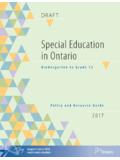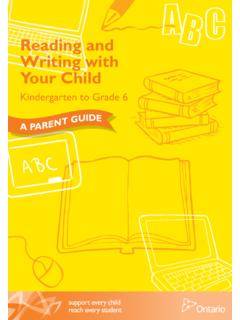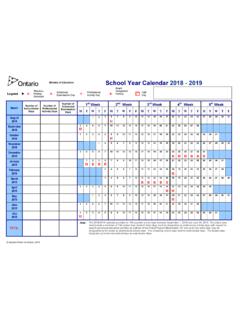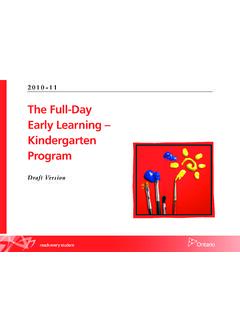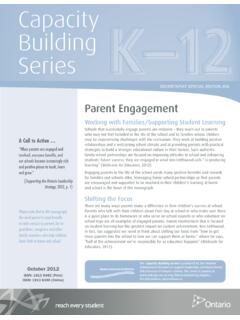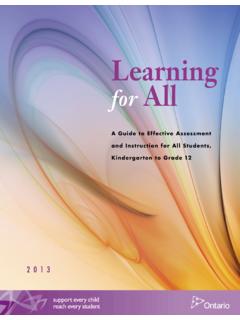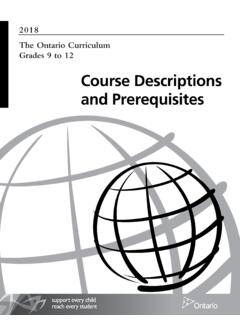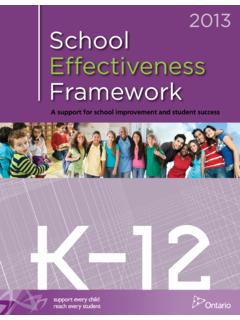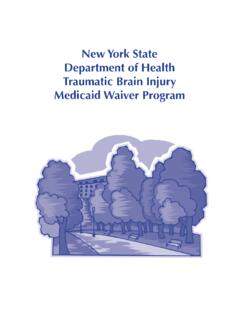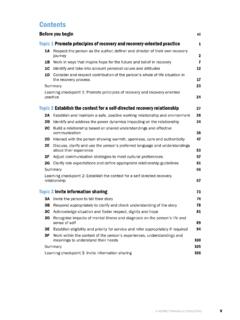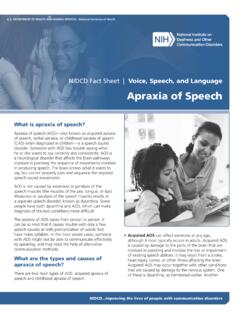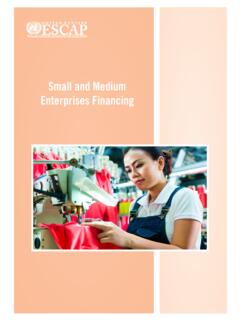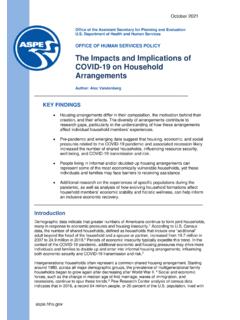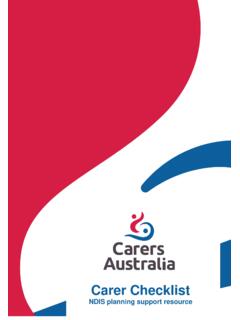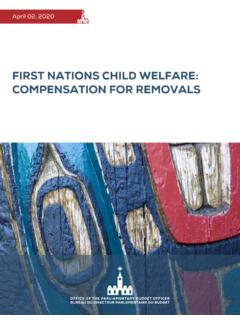Transcription of Everyone is Welcome: Inclusive Early Childhood Education ...
1 Everyone Is welcome : Inclusive Early Childhood Education and CareWritten by Dr. Kathryn UnderwoodRyerson UniversitySupporting all children to fully participate in their communities requires high quality Early Childhood Education and Care (ECEC) experiences. High quality Inclusive ECEC programs have three key components: they are accessible to all children and their families; they are designed and carried out with consideration for the unique needs of each child; and they include ongoing evaluation of programs to ensure full participation (Underwood & Frankel, 2012). In high quality ECEC programs all children have opportunities to develop their language, social, physical and cognitive abilities. Inclusive Early Education is not just about placement in a program, but also active participation in social interactions and the development of children s abilities and skills.
2 Children at a range of developmental levels, including children identified with special needs in the ECEC service system, should be welcomed as valued members of the community by supporting active participation in all Early Childhood settings (Underwood, Valeo & Wood, 2012). AccessEarly Childhood Education and Care programs are Inclusive when they have: Policies that promote inclusion Leadership that supports inclusion Staff who believe in inclusionIn order for all children to fully participate in Education , care and community, they must have equitable access to programs. Early Childhood Education and care programs should have an inclusion policy that states the anti-discriminatory policies for enrolment, BLEED2 Everyone is welcome : Inclusive Early Childhood Education and Carechildren s behaviour, and programming in the centre.
3 Service agencies must also have access to the supports they need to meet all children s needs. In many settings, resource consultants are available to support staff in inclusion efforts. For programs that do not have a regular resource consultant, partnerships with other agencies and Early intervention programs can provide resource teachers, specialists, community-based professionals, funding and support for parent-educator partnerships. Early intervention and resource consultants can build a relationship with ECEC staff that results in problem solving between all stakeholders within the child care system including with families (Buysee & Hollingsworth, 2009; Frankel & Underwood, 2011; Guralnick, 2011). As an example, these external support staff might provide a parallel program, such as speech and language intervention, and a child care centre can help the family to monitor the child s development, and provide opportunities for social participation using language.
4 The relationships across services and professionals should be coordinated and collaborative. The service sectors that provide these supports include health, Education , social services, and care services. These teams of professionals can support assessment, planning, design of adaptations and accommodations, and program evaluation. As an example, a family physician can refer a child who has difficulty with social interaction to a drop-in at an Ontario Early Years Centre where there are opportunities for social interactions with other children. Design and ImplementationPrograms are Inclusive when: The program is designed to meet the needs of all children and families (universal design) Planning is individualized and the goal of participation is explicit Early intervention goals for the child are accommodated and embedded within the program (differentiation)Physical resources that are important for Inclusive practice include an accessible environ-ment that provides adaptive materials, specialized equipment and a well-planned layout.
5 Many of the materials and environments that are identified in high quality Early Childhood Education overall are consistent with high quality inclusion (Irwin, Lero & Brophy, 2004; Buysee & Hollingsworth, 2009). Staff in ECEC programs can use the range of materials they have for multi-age programs to adapt activities for all children. For example, large pencils for young children work well for older children who have fine motor difficulties. Programs that are able to provide both quiet and active areas are good for children with a range of attention and sensory needs. Programs that respect the natural pace of each child s development and the family context are also Inclusive (Frankel & Underwood, 2012).Individualized planning should be documented so that it can then be shared with parents, specialists and the child themselves to ensure it meets the child s needs (Savaria, Underwood & Sinclair, 2011).
6 Development of an Individualised Program Plan (IPP), 3 Dr. Kathryn Underwood or an equivalent documentation of individual approaches, will ensure intentional planning within the program and will help with information sharing amongst professionals, agencies and with families. For some families, children are accessing multiple services. This can mean that multiple assessments are conducted, and families are asked to support planning with each service. The IPP can record activities and routines in the program from the perspective of the child, and can be shared with other professionals with the permission of the family . Most importantly the goals of the IPP should focus on participation rather than on what is normal . This means that the child should have opportunities to be physically active, have fun, and make friends (Rosenbaum & Gorter, 2011).
7 The IPP may also have identified resources, so it is important to work with the family to coordinate supports and programming (Janus, Lefort, Cameron & Kopechanski, 2007; Irwin, Brophy & Lero, 2004).The IPP should also include any therapeutic goals that are identified in other programs in which the child participates. Embedding Early intervention strategies into child care, family support programs, and family routines, supports the transfer of developmental skills across contexts (Guralnick, 2011; Cross, Traub, Hutter-Pishgahi & Shelton, 2004). The IPP should outline any additional staffing, communication strategies, equipment, and ratios or grouping that need to be adapted, along with funding that is associated with supports and program adaptations (Frankel & Underwood, 2012). Funding for supports can be identified with the support of municipal Early intervention and resource programs and other service providers funded through the Ministry of Education and the Ministry of Children and Youth Services (Underwood, 2012).
8 Monitoring and AssessmentChildren and families continue to be included when: Professionals respond to developmental changes in children and changes in family life Programs are flexible, responsive and use up-to-date information to plan and make decisions There is a smooth transition from Early Childhood to schoolA critical factor in high quality Inclusive settings is ongoing monitoring of the success of the program. As children grow and develop, and as the group of children in the community changes, the program must adapt. Therefore, ECEC programs need to monitor the changing needs of children, their families, and communities, as well as new information they gain through monitoring both the children and the program. Knowledge of children s individual development through informal observation and more formal assessment activities (carried out by the appropriate professional), 4 Everyone is welcome : Inclusive Early Childhood Education and Carematched with environmental assessments of program activities and spaces, is critical in Inclusive Early Childhood programming.
9 Early Childhood programs also support families with referrals for diagnostic assessment. The value of a range of assessment and monitoring practices over time is that as more children participate and the ECEC programs gain knowledge about adapting programs and making the physical space and equipment accessible for a wider range of children (Cross et al., 2004).In order for families and ECEC providers to have the supports they need, they must be aware of the supports that are available. Families gain awareness of programs through personal networks (friends and family ), referrals and advertising (Underwood & Killoran, 2012). ECEC providers are part of a network of professionals, and can provide referrals and information about the range of programs in their community. In order to be knowledgeable about services, ECEC providers need to be active in their professional changes have taken place over the last decade in how and where we deliver supports to children identified as having special needs and their families.
10 Also, changes in other programs can affect Early Childhood service delivery, for example as Full-Day Kindergarten is implemented. It is important that ECEC providers are able to communi-cate with school staff to ensure a good transition as children with special Education needs spend more time in Childhood programs that are effective at monitoring and assessment are well positioned to support families and children as they transition to school. Transitions to school are a critical time for all children, but research suggests that transition issues are much more pronounced for children with identified special needs than other children (Janus et al., 2007; Lloyd, Irwin & Hertzman, 2009). In order to support children with special educational needs transitioning into schools, it is important to coordinate the sharing of information among Early Childhood services, schools and parents.
